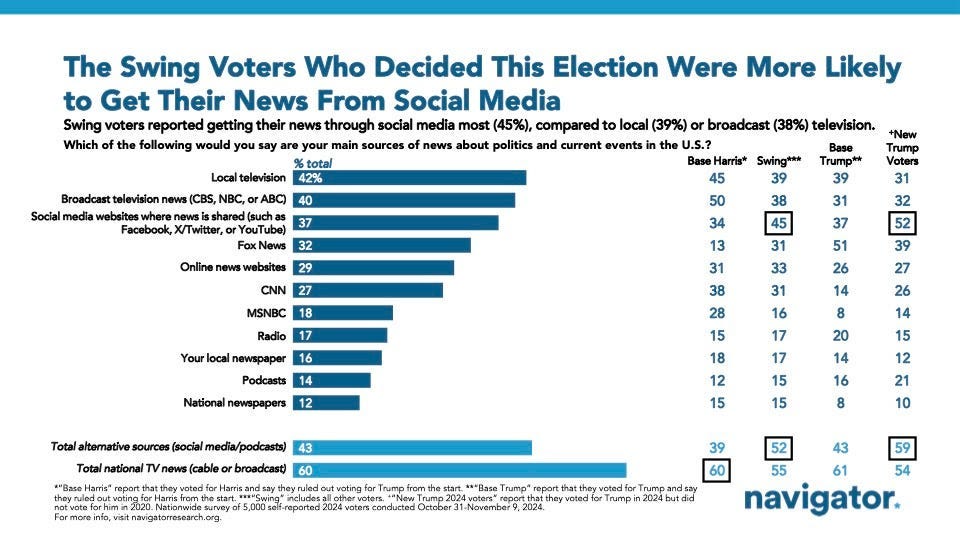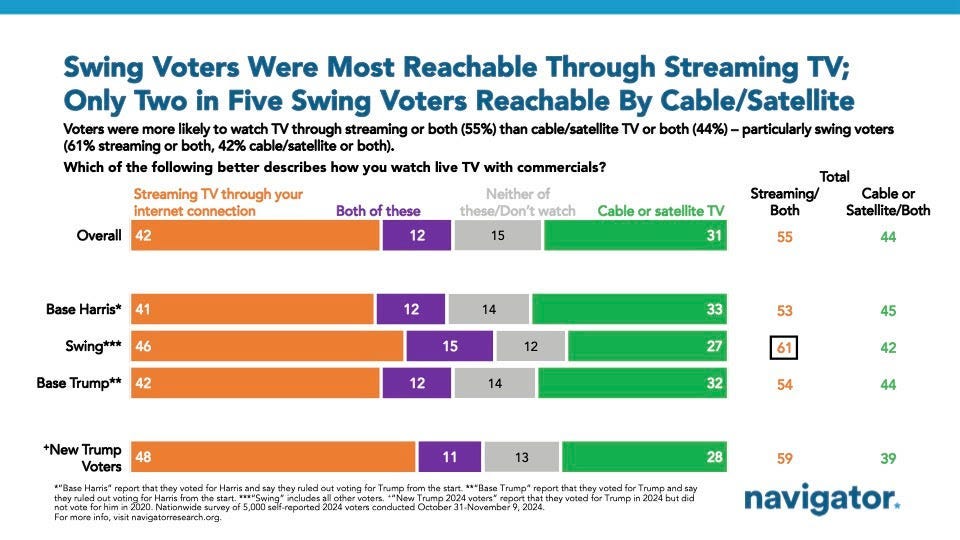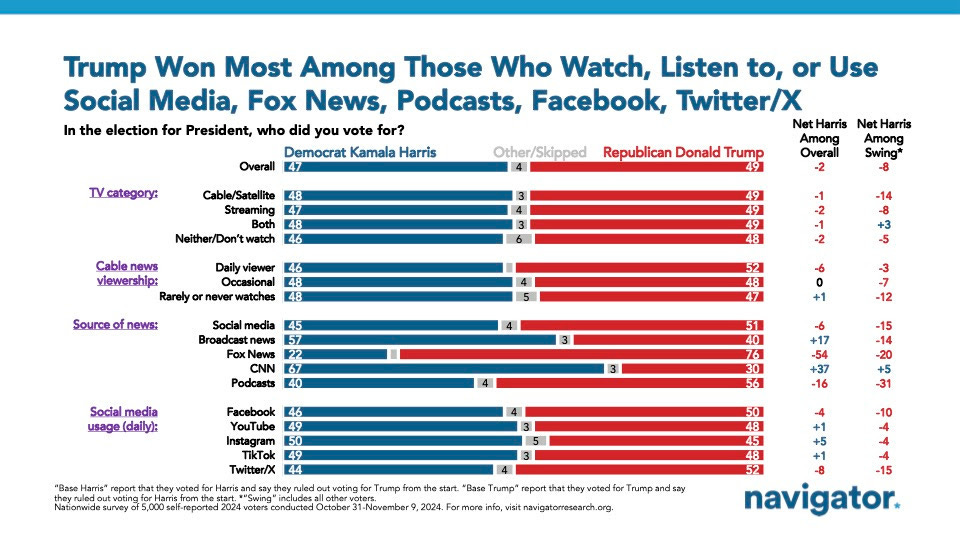Thank you for being one of the 100,000 members of the Message Box community. This inspiring group includes political activists, operatives, candidates, and volunteers. I know many of us are still processing the brutal election results. In the coming weeks and months, Message Box will focus on three key priorities:
I hope you’ll follow along and join me in this important process. Thank you for your continued support Dan Why Republicans are Winning the Message WarA new poll shows that swing voters are not hearing what we have to say.We are in the midst of a big, vituperative debate within the Democratic Party about Harris’s campaign message. Was she insufficiently populist? Too moderate? Not moderate enough? Should she have talked inflation more? What about abortion and democracy? I could go on forever. The chatter is endless. There is no question that the Democratic message needs work. Voters who supported us for years left us for Trump. We considered ourselves the party of the working class, and the working class voted for the other guy. Clearly, we have a message (and a policy) problem. However, a new post-election study shows that Democrats have more than a message problem. We have a message delivery problem. The voters who decided the election simply weren’t hearing what Democrats were saying. Democrats at every level — from elected officials to communications staffers to activists posting about politics online — should read this election exit survey of 5000 voters from Navigator Research. This post is part of a series of posts discussing how Trump out messaged us in the 2024 election and what we can do in the future. If you want to follow along, please consider becoming a paid subscriber. If you find the information in this post useful, please share it with your network. Swing Voters Don’t Consume Traditional NewsTrump didn’t do a single legacy media interview for the last month of the campaign. He didn’t sit down with a cable network. He attended no roundtables with reporters or sit downs with local TV anchors in key markets. He backed out of interviews with 60 Minutes, CNBC, and NBC News. Trump also turned down a primetime CNN townhall in the final weeks. Instead, he talked to Joe Rogan and other political podcasters. It paid off. Polling before and after the election showed Harris performing well with voters who consume the most news, and conversely, Trump running up big margins with those who consume the least. However, the Navigator story offers more detail on the media diets of the voters who decided the elections. The study focuses on two types of voters — swing voters and new Trump voters. Swing voters are people who didn’t rule out voting for either candidate from the start and new Trump voters are people who voted for Trump in 2024 but didn’t vote for him in 2020. This last group includes people Trump brought into the electorate and those who switched from Biden to Trump (There is overlap between the two groups). What’s even more surprising is that swing and new Trump voters are most likely to get their news from social media. Very few of them are getting news from legacy media. Only 16% of swing voters watch MSNBC and only 15% get their news from national newspapers. Think of all of the time spent fretting about New York Times headlines and stories — none of the voters who were on the fence ever saw them. It was just an internal conversation among people who decided to vote against Donald Trump years ago. CNN loves to tout the finding that 31% of swing voters get news from their network, but their low ratings make me quite skeptical that they are regular viewers. More likely, they turn to CNN during major news events. The main takeaway from all of this data is that legacy media is an inefficient way to reach persuadable voters and any communications strategy centered on those traditional outlets is doomed to fail. The Harris campaign did lots of innovative non-traditional stuff like the Call Her Daddy and All the Smoke podcasts. However, I look back at the time spent on legacy media, like the CNN town hall and the interview with NBC News, and wonder what the upside was. The Move to Streaming is a Big DealSwing voters are also more likely to have cut the cable cord and depend on streaming services. Only 27% of swing voters watch cable or satellite TV. Republicans have a significant messaging advantage. They have Fox, an array of Right Wing media outlets, and Right or MAGA-adjacent influencers tend to dominate on YouTube and TikTok. In recent elections, Democrats leveled the playing field by running more paid advertising. We have a better grassroots fundraising machine, so our campaigns have more money to spend. The GOP tries to balance the scales with billionaire-funded Super PACs, but because of campaign finance laws, campaign funds go much further than Super PAC money. An ad from a Super PAC costs five times as much as one from a campaign in many markets during the 2024 cycle. If more than half of swing voters have cut the cord, it becomes much harder for Democrats to reach them through paid advertising. Most streaming services offer an ad tier, where consumers can pay less per month but have to watch commercials. However, reaching people through these services is more complicated than through linear television. Netflix is the biggest streamer by far, yet most Netflix users aren’t on the ad tier; and even for those who are, Netflix is one of a handful of services that don’t allow political ads. Relying on TV ads to reach voters is a suboptimal strategy, and a very inefficient way to reach the voters we need most. The Podcast ElectionIn the runup to and aftermath of the election, a number of observers referred to 2024 as the “podcast election.” While a little oversimplified, that designation made sense. Other than the debate, the two most high-profile media moments were the Rogan and Call Her Daddy interviews. While Harris did several podcasts, Trump made podcasts the central focus of his strategy. Unsurprisingly, according to Navigator Research, Trump won swing voters who listen to podcasts by 31 points. While the polls show that only 16% of swing voters get their news from podcasts, it seems that podcasts were particularly influential in their choice. This makes sense for two reasons. First, listeners tend to trust podcast hosts more than any other media figures because of the intimacy of the medium. Second, podcast clips particularly those from Rogan and Alex Cooper, the host of Call Her Daddy, tend to get a lot of engagement on TikTok, Instagram, and YouTube. Even people who don’t subscribe to a particular podcast (or any podcast) were likely to see some of these interviews. As a podcast co-host myself, I am undeniably biased about the importance of podcasts. However, long-form audio is a growing force in political media Democrats need a better, more compelling story to tell voters. We also need new, more populist policies that address people’s dissatisfaction with the economy and the political system. But even if we solve that problem and introduce the perfect message, it won’t matter if no one hears it. Fixing our problem begins with understanding why so few people heard what we had to say in this last election. You're currently a free subscriber to The Message Box. For the full experience, upgrade your subscription. |
Tuesday, December 10, 2024
Why Republicans are Winning the Message War
Subscribe to:
Post Comments (Atom)
-
Women's health has been ignored for most of history. This venture capitalist says that's changing. View this email in your browse...
-
A cautionary note on a very funny meme ͏ ͏ ͏ ͏ ͏ ͏ ͏ ͏ ͏ ͏ ͏ ͏ ͏ ͏ ͏ ...
-
Splurges for the C-suite … Die Hard holiday marketing … Pizza Hut's Book It! Turns 40 If you've applied to jobs throughout 2024 wit...






No comments:
Post a Comment